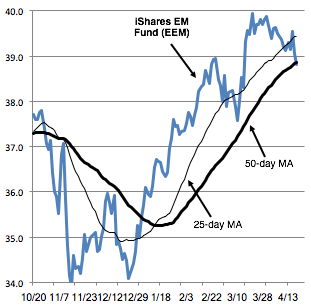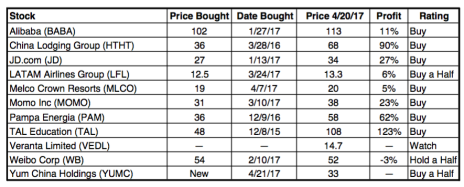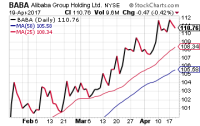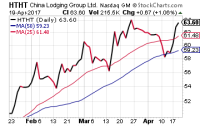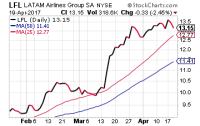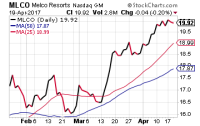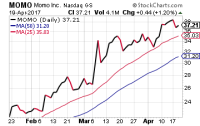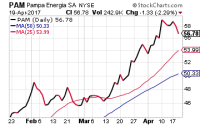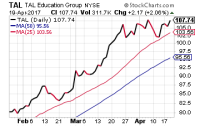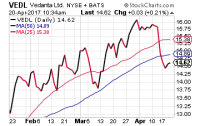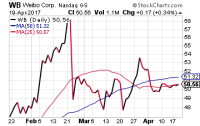Most of our recommended stocks are acting great, and our new recommendation checks many of the boxes we look for when hunting for a long-term winner. It is a dominant restaurant company in China, and the stock just got going after a few months of base-building.
Cabot Emerging Markets Investor 631
[premium_html_toc post_id="133126"]
Cabot Emerging Markets Timer
The Emerging Markets Timer is our disciplined method for staying on the right side of the emerging markets. The Timer is bullish when the index is above the lower of its two moving averages and that moving average is trending up.
Our Emerging Markets Timer is still bullish, but the next few days will be telling. The iShares EM Fund (EEM) isn’t in terrible shape—it’s just 2.5% or so from a multi-year high—but this week’s retreat has brought it down to its 50-day line for the first time since early March.
So far, this action is acceptable and, combined with the resilient action from most of our stocks, keeps us bullish. But we’ll be watching things closely in the days ahead, as much more weakness could produce a sell signal and have us trimming our sails.
Good News
Lots of pundits seem to get a kick out of writing about China and the U.S. as if the two were dedicated enemies and on track for some kind of global confrontation. But there is a separate, more comforting reality. The truth is that both countries are economic superpowers that very much need one another to succeed. The U.S. needs China as both a source of inexpensive manufacturing services and as a rapidly maturing market for digital devices, autos and movies (among other goods).
For its part, China needs the U.S. (and Europe, taken collectively) as a market for its exports. A hungry U.S. consumer is good news for China, even as that country tries to quicken its transition to a more internally focused goods & services economy. It takes a lot of economic power to shift the basis of a major economy.
That’s why it’s such good news that China’s March trade data came in as strong as it did, which is pretty darn strong. China’s National Bureau of Statistics says that exports grew by 16.4% in U.S. dollar terms, which is the biggest increase since February 2015. It’s also a nice turnaround from the month before,
when exports actually fell by 1.3%. (The timing of the Chinese lunar New Year was partly responsible for that decline, but a dip is a dip.)
Also in the plus column was the unexpectedly strong increase in Chinese imports, which came in at 18%, which was ahead of expectations. And imports of industrial commodities like copper, iron ore, coal and crude oil all stepped up significantly, with crude imports registering the largest monthly total on record.
The two-fisted increases in both exports and imports have a positive message about China, but even more about the general health of the global economy, in which China is both a supplier and a consumer.
All told, the bullish trade data (along with a strong housing market and lots of infrastructure activity) contributed to a better-than-expected GDP reading in the first quarter. The Chinese economy grew 6.9% in Q1, the fastest uptick since the third quarter of 2015. While many expect growth to slow some later this year, it’s clear that China still has the wind at its back.
In the meantime, although the U.S. President now says that China is not a currency manipulator, there will likely remain a portfolio of significant issues for the U.S. and China to work out. Chinese claims in the South China Sea, a unified policy toward nuclear power North Korea and agreement on trade barriers are major challenges. But a healthy China as an engine of global economic growth and increasing economic interdependence is good news all around.
Featured Stock
Yum China (YUMC)
A Delicious Long-Term Growth Story
Yum China is a new stock (though not a new company) that checks most of the boxes we look at when evaluating potential winners. Big company that’s a leader in its field? Check. History of solid growth? Check. Long runway of growth going forward? Check. And a stock that recently lifted into an uptrend? Yes!
Yum China is the Chinese arm of Yum! Brands, the global quick service restaurant giant. It was spun off from its parent company last October, but it’s been operating in China for a long time—the company recently celebrated the 30th anniversary of its first store in that country.
Today Yum China is far and away the leading western quick service restaurant operator in China. At the end of March, the company had 7,663 restaurants (nearly 5,300 were KFC locations, about 1,700 were Pizza Huts with the rest a mix of Taco Bell and a couple of newer, home-grown brands) that attract a combined two billion customer visits annually. For comparison, McDonalds has “only” 2,223 restaurants in China, while Starbucks operates 2,171 locations.
Despite its size, management sees plenty of growth potential ahead. In the first quarter, the firm opened 133 new stores (72 of which were KFC) and is aiming for 550 to 600 new openings for all of 2017 (including entering nine new cities), which would be a 7.6% boost in total restaurants. Long-term, given China’s booming urban population and the relative under-penetration of quick-service restaurants in cities, Yum China sees the potential to triple its restaurant count.
And those stores have generally paid back the company pretty quickly. On a pre-tax basis, new KFC openings have returned Yum’s initial investment within three years, while new Pizza Hut dining locations pay back in a bit less than four years. Those aren’t the best metrics we’ve ever seen, but they’re certainly good enough to generate solid returns and allow management to continue its steady store expansion.
As for the here and now, Yum’s stores are doing pretty well, though growth is sluggish. In the first quarter, same-store sales rose 1%, though system-wide sales rose 4% on a currency-neutral basis. Interestingly, the company has been very active in keeping customers returning by using both loyalty programs (70 million loyalty members to KFC in China and another 23 million for Pizza Hut, all of which get special offers) and technology (31% of payments are now mobile). Delivery sales now account for 12% of the total, a figure that’s been rising recently.
Thanks to cost controls and greater efficiencies from a larger network of stores, first-quarter operating profit was up 27% on a currency-neutral basis, while earnings rose 19%, easily topping expectations. Importantly, free cash flow of $283 million was much larger than net income, boosting Yum China’s cash position to a strong $1.2 billion.
From here, it’s just a matter of executing on the growth plan—with China’s overall economy continuing to crank ahead, Yum China needs to boost same-store sales growth, keep costs in check and steadily boost the store count. Analysts see sales rising about 3% this year (likely 5% to 6% on a currency-neutral basis) while earnings rise 17% from a year ago.
The stock certainly portends good things down the road. YUMC had a good first month after being spun off, but then began a very tight multi-month base—notice how shares spent many weeks in the 25.5 to 27 range during December/January, and, after a brief blip higher, again in February/March. Such action is usually a sign of accumulation, as big investors pick up shares in a certain price zone.
And now the stock is freewheeling, after having surged to new highs following its earnings report and following through to the upside in recent days. The chart looks great, but given the market’s recent wobbles, YUMC’s recent run-up and our relatively small cash position, we’re going to play it a bit conservatively here—we’ll take a half-sized position tomorrow and look to average up if things go well in the weeks ahead. BUY A HALF.
Yum China Holdings (YUMC 33)
Two Grand Gateway
16th Floor
Shanghai 200030China
www.yumchina.com
Model Portfolio
Invested 85% Cash 15%
Updates
The mushy action of the U.S. markets is beginning to spill over to emerging market stocks, with the iShares EM Fund (EEM) testing its key 50-day moving average yesterday. The intermediate-term trend is still up, so we’re still bullish, but we’ll be watching the action closely in the days ahead. In the meantime, we’re continuing to keep our lagging stocks on tight leashes, and we’re going to buy only a half-sized position in Yum China.
The good news is that most of our recommended stocks are acting just fine, with most remaining in solid uptrends. We have no ratings changes tonight.
Alibaba’s (BABA) surged to a multi-year high today on excellent volume, a great sign of relative strength. The stock’s story, numbers and chart all point toward higher prices once the market’s longer-term uptrend resumes. Earnings are likely out in early May. BUY.
China Lodging Group (HTHT) had a couple of ugly days early last week, but shares have sprung off their 50-day line in heavy volume, soaring to new highs today. As we’ve written before, the stock has been running for a while, so we’re looking for any signs of abnormal weakness. But, clearly, big investors are still taking advantage of dips, so we think you can, too; try to grab shares on a pullback of a couple of points. BUY.
Except for a shakeout on March 21, JD.com (JD) has been in a relatively smooth uptrend for all of 2017. And why not? Earnings are finally set to surge as the company’s big investments in recent years pay off. After popping to new highs during the past two days, it’s probably best to pick up shares on dips of a point or so. BUY.
LATAM Airlines (LFL) has hit a little turbulence in the 13.5 area in recent days, but this comes after the stock’s very powerful breakout-and-follow-through action (from 10.5 to 13.7) during the past month, so some hesitation is normal. Barring a complete market meltdown, the recent action bodes well, as does the steady improvement in the fundamentals (traffic was up 2.1% in March, with a load factor of nearly 83%). You can buy a small position here or on dips below 13. BUY A HALF.
Melco Resorts (MLCO) is another Chinese stock that’s hitting new highs despite the tricky environment. Fitch Ratings now projects Macau gaming revenue will grow 12% in 2017 (year-to-date growth has been 13% on a year-over-year basis), with both VIP and mass-market revenues performing well. With earnings firmly on the comeback trail (bolstered by a new luxury hotel opening next April), we think MLCO’s path of least resistance is up. Earnings are likely out in mid-May. BUY.
Momo (MOMO) isn’t well known, yet it probably has as much potential as any stock in China right now. Demand for the firm’s new video services is going bananas, driving wild growth (revenues were up 524% last quarter!) and crushing earnings estimates. While the stock is very volatile, we’re extremely impressed with how MOMO has held up (it surged to new highs last week before retreating a bit in recent days) given its huge run since December. If and when the market kicks into gear, we think MOMO could do very well. Hold on if you own it, and if you don’t, consider buying a little here or (preferably) on dips of a point or two. BUY.
Pampa Energia (PAM) inning to pull back in recent days. It’s not early in the stock’s run, but the stock continues to act very well. We’ll stay on Buy, but if you want in, try to buy on dips of another couple of points; a few weeks of rest wouldn’t surprise us after the recent advance. BUY.
TAL Education (TAL) has encountered some distribution in the mid-100s during the past couple of weeks, though that’s not unusual given the market’s wobbles. So far, shares have held the 25-day line, so it’s not as if the sellers have made much headway. The big event will come next Thursday (April 27), when earnings will be released—analysts are looking for revenues to rise 65% and earnings of 30 cents per share (up 30% from a year ago). Keep any new positions small ahead of the report. BUY.
Vendanta (VEDL) isn’t acting great, but we’re willing to cut it some slack here given the market and its recent key acquisition of Cairn India, which is a huge oil producer in that country. We’ll keep it on our Watch List. WATCH.
Weibo (WB) has quieted down nicely in recent weeks, holding around 50, and that’s probably a good sign that most of the sellers have left the vicinity. Remember, too, that this action comes after what has effectively been six months of consolidation. WB isn’t strong enough for a Buy rating, but we think your best move is to hang onto your small position; we still believe the stock can do very well if and when it kicks into gear. HOLD A HALF.
[premium_html_footer]
Send questions or comments to paul@cabotwealth.com.
Cabot Emerging Markets Investor • 176 North Street, Salem, MA 01970 • www.cabotwealth.com
All Cabot Emerging Markets Investor buy and sell recommendations are made in issues or updates and posted on the Cabot subscribers’ website. Sell recommendations may also be sent to subscribers as special alerts via email. To calculate the performance of the hypothetical portfolio, Cabot “buys” and “sells” at the midpoint of the high and low prices of the stock on the day following the recommendation. Cabot’s policy is to sell any stock that shows a loss of 20% in a bull market (15% in a bear market) from our original buy price, calculated using the current closing (not intra-day) price. Subscribers should apply loss limits based on their own personal purchase prices.
THE NEXT CABOT EMERGING MARKETS INVESTOR IS SCHEDULED FOR APRIL 27, 2017
We appreciate your feedback on this issue. Follow the link below to complete our subscriber satisfaction survey: Go to: www.surveymonkey.com/chinasurvey
Cabot Emerging Markets Investor is published by Cabot Wealth Network, an independent publisher of investment advice since 1970. Neither Cabot Wealth Network, nor our employees, are compensated in any way by the companies whose stocks we recommend. Sources of information are believed to be reliable, but they are in no way guaranteed to be complete or without error. Recommendations, opinions or suggestions are given with the understanding that subscribers acting on information assume all risks involved. © Cabot Wealth Network 2017. Copying and/or electronic transmission of this report is a violation of the copyright law. For the protection of our subscribers, if copyright laws are violated, the subscription will be terminated. To subscribe or for information on our privacy policy, visit www.cabotwealth.com, write to support@cabotwealth.com or call 978-745-5532.
[/premium_html_footer]

